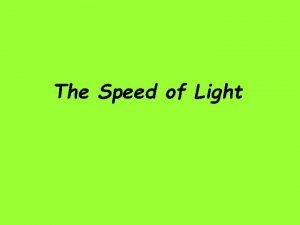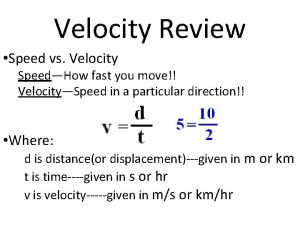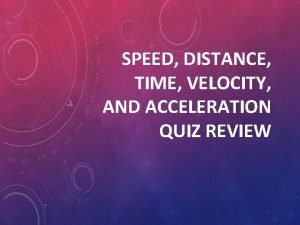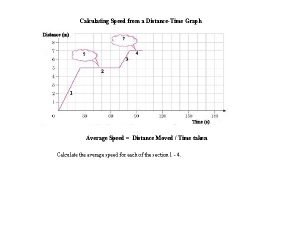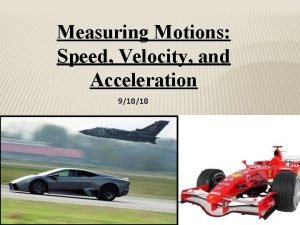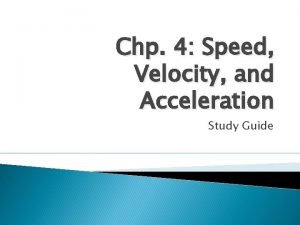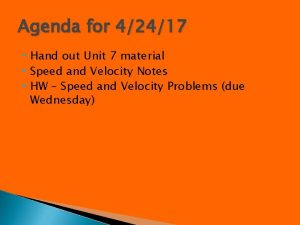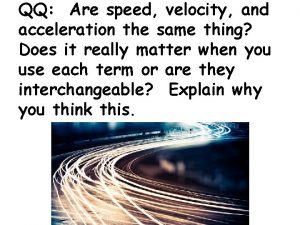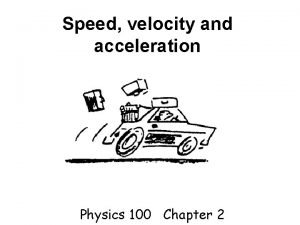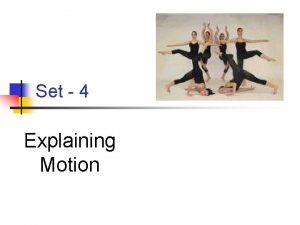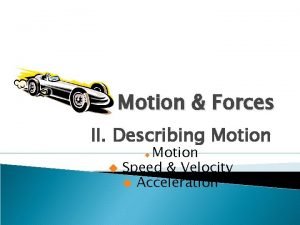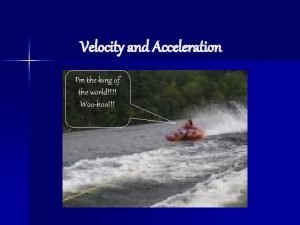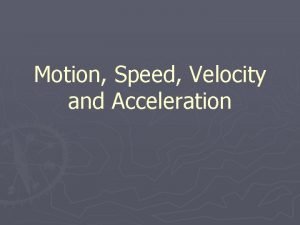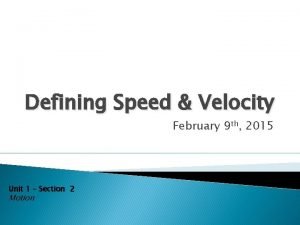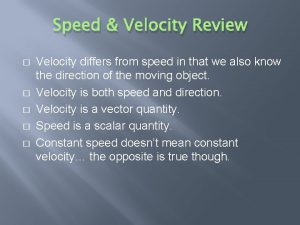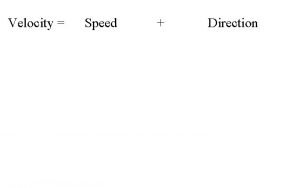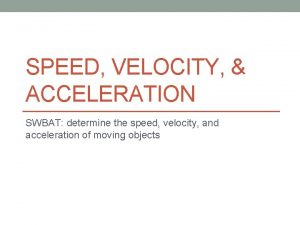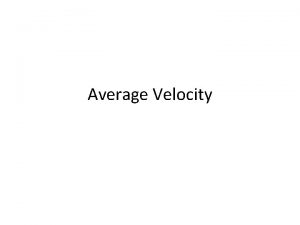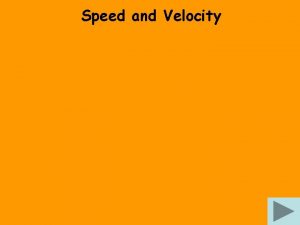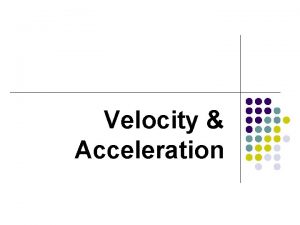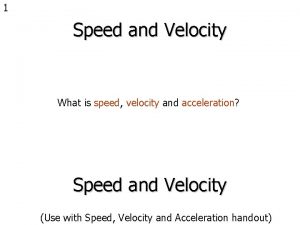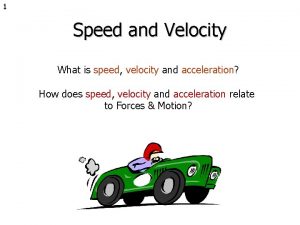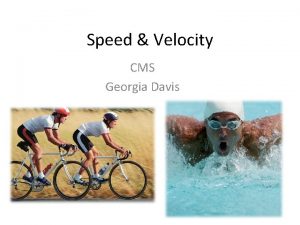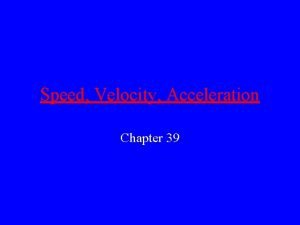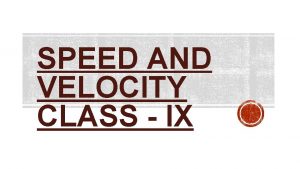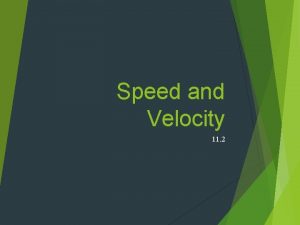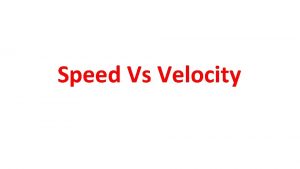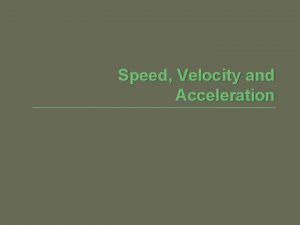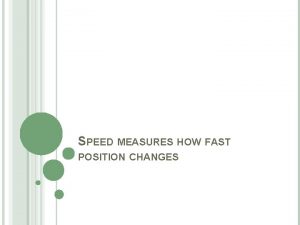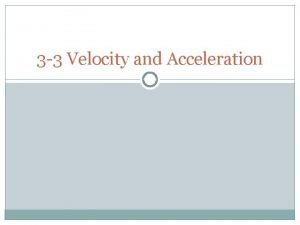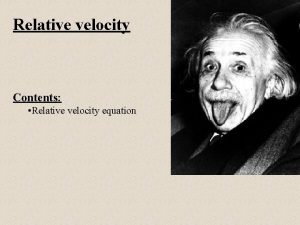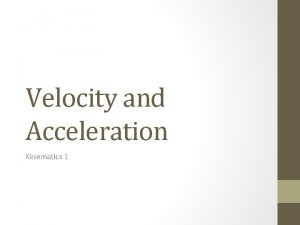Velocity Review Speed vs Velocity SpeedHow fast you


































- Slides: 34

Velocity Review • Speed vs. Velocity Speed—How fast you move!! Velocity—Speed in a particular direction!! • Where: d is distance(or displacement)---given in m or km t is time----given in s or hr v is velocity-----given in m/s or km/hr

Velocity Vector Addition: Same direction: 15 m/s 6 m/s add them, keep same direction E E Opposite Direction: Up 50 m/s 21 m/s 20 m/s subtract them, keep direction of the larger!! Up 30 m/s down E

Velocity Review(cont. ) Slope of a distance vs. time graph is equal to the velocity!!! Always!!! If slope is straight, velocity is constant! If slope is not straight, velocity is not constant(it is changing)!!

Velocity Review(cont. )

Velocity Review(cont. )

Velocity Review(cont. )

Velocity Review(cont. )

Accelerated Motion

Acceleration • Defined as a rate of change of velocity. • In order to accelerate, an objects’ velocity must change!! • 3 ways to change velocity: 1. Speed up. 2. Slow down. 3. Change direction

Which of these pictures represents acceleration? Why? ?

Which vehicle is accelerating? How can we tell?

Acceleration Equation Where: vf = final velocity(in m/s) vi = initial velocity(in m/s) t = time(in s) a = acceleration(in m/s/s or m/s 2)

Ex. ) A police car changes its velocity from 5 m/s to 20 m/s in 4 s. Find the rate of acceleration of the car. Given: vi = 5 m/s vf = 20 m/s t= 4 s a=?

Ex. ) A ball rolling down a hill accelerates from 3 m/s to 8 m/s in 2. 4 s. What is the rate of acceleration of the ball as it rolls down the hill? Given: vi = 3 m/s vf = 8 m/s t = 2. 4 s a=?

A roller coaster slows from 24 m/s to 8 m/s in 2. 5 s. Find the rate of acceleration of the roller coaster. Given: vi = 24 m/s vf = 8 m/s t = 2. 5 s a=? Negative, therefore slowing down.

Ex. ) A world class sprinter can accelerate from rest to a velocity of 10 m/s in 1. 8 s. Determine the rate of acceleration of the sprinter? Given: vi = 0 m/s vf = 10 m/s t = 1. 8 s a=?

Ex. ) While driving down the road at 14 m/s, a dog runs out in the road in front of you. You slam on brakes and come to a complete stop in 3. 5 s. Find the rate of acceleration. Given: vi =14 m/s vf = 0 m/s t = 3. 5 s a=? Negative, therefore slowing down!!

A neighborhood dog sees a cat walking down the street and starts to chase it. The dog accelerates from 2 m/s to 5 m/s in 1. 8 s. What is the acceleration of the dog? A. B. C. D. 1. 1 m/s/s 1. 67 m/s/s 2. 78 m/s/s 3. 89 m/s/s

Dale Jr. leaves his pit stall and accelerates from rest at a rate of 4. 7 m/s 2. What velocity will Dale Jr. achieve in 5. 2 s? A. 24. 4 m/s B. 18. 3 m/s C. 10. 1 m/s D. 8. 43 m/s

Velocity-Time Graphs What does the slope of a velocity time graph represent? Slope = rise run = velocity time = vf –vi time = acceleration

When does the slope of a velocity time graph = acceleration? Always, you Clown!!!

Take a break!! Don’t copy the next few slides. Just Pay attention!!! P. S. I’ve got a ring now just like my big brother!!!

+ slope= + acceleration Object is getting faster!!!

- slope= - acceleration Object is getting slower!!!

1. Is this object moving? i. Does it have a velocity? 2. What is the objects’ acceleration?

Because velocity is a vector quantity, direction is important. + velocities indicates one direction - velocities indicates the opposite direction + velocities - velocities

• Slopes on a velocity time graph = the acceleration. • + slopes = + acceleration • - slopes = - acceleration When line is moving away from the x axis, acceleration is +(speeding up). When line is moving toward the x axis, acceleration is –(slowing down).

Getting Slower 1. Where is object getting faster? 2. Where is object getting slower? 3. Where does object stop and change direction? Stop, and change direction!! Getting Faster

If I were you guys, I would copy the next Slide!!! I bet the class didn’t know that Mr. Eidson is the President of my fan club!!!

Starting on far left hand side of graph, explain what is happening with the motion of the object? + slope = speeding up - slope = slowing down 1. Stops 2. Changes Direction + slope = speeding up - slope = slowing down

Explain the difference in these two graphs?

Which of the following graphs represent an object moving at a constant velocity? A B C D

Which of the following graphs represent an object slowing down? A B C D

Which 2 graphs could represent the same motion? A. 1 and 2 1 2 3 4 B. 2 and 3 C. 1 and 4 D. 3 and 4
 Non acid fast bacteria
Non acid fast bacteria Example of acid-fast bacteria
Example of acid-fast bacteria How fast does light travel
How fast does light travel Find speed
Find speed Strong emotions can interfere with your ability to
Strong emotions can interfere with your ability to Speed detection of moving vehicle using speed cameras
Speed detection of moving vehicle using speed cameras P m v triangle
P m v triangle Speed v velocity
Speed v velocity The velocity changes from 45m/s
The velocity changes from 45m/s Speed velocity and acceleration quiz
Speed velocity and acceleration quiz Speed velocity and acceleration problems answers
Speed velocity and acceleration problems answers Differentiate between average speed and average velocity
Differentiate between average speed and average velocity Light travels 3 00 000 km/s. is it velocity or speed
Light travels 3 00 000 km/s. is it velocity or speed Velocity v speed
Velocity v speed Constant speed on distance time graph
Constant speed on distance time graph How to calculate average speed from a distance time graph
How to calculate average speed from a distance time graph Speed, velocity, and acceleration
Speed, velocity, and acceleration Constant speed
Constant speed What is velocity
What is velocity Speed velocity and acceleration study guide answers
Speed velocity and acceleration study guide answers Speed challenge lab
Speed challenge lab Are speed velocity and acceleration the same thing
Are speed velocity and acceleration the same thing Graph the particle's velocity and speed where defined
Graph the particle's velocity and speed where defined The main difference between speed and velocity involves
The main difference between speed and velocity involves What is acceleration
What is acceleration Chapter 1 lesson 2 speed and velocity answer key
Chapter 1 lesson 2 speed and velocity answer key What is velocity
What is velocity Speed vs velocity
Speed vs velocity Velocity and speed
Velocity and speed F= ma units
F= ma units Difference between speed and velocity
Difference between speed and velocity Describe the motion
Describe the motion Velocity describes both speed and
Velocity describes both speed and Speed and velocity
Speed and velocity Speed and velocity
Speed and velocity


